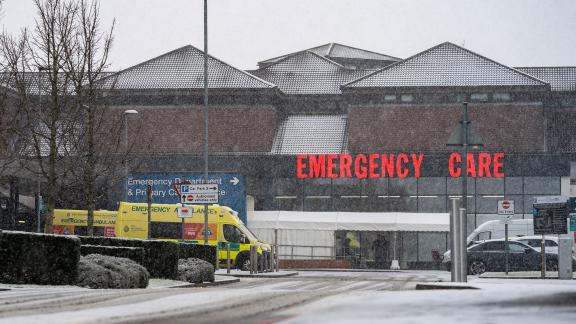Analysis: the latest statistics on NHS England’s six key metrics for winter

As we head towards winter, we consider what the latest statistics mean for a service already under strain, showing the challenging situation the NHS already faces before winter pressures which may include further COVID-19 challenges and flu.
At a glance
- NHS England’s timely plan for increasing capacity and operational resilience in urgent and emergency care, released on 12 August, identified six key metrics to measure success this winter. This includes category 2 ambulance response times, adult general and acute bed occupancy, and average hours lost to ambulance handover delays. The plan will form the basis for the provision of safe and effective urgent and emergency care over the coming months.
- Following yesterday’s release of the latest bed occupancy data and the monthly performance statistics the previous week, we assess the relevance of these metrics, how the NHS is performing now, during the summer months, and what it will take to improve, considering historical performance levels.
- The latest data confirms that the shock created by the pandemic continues to impact patient flow and therefore performance across the board. For instance, we see issues discharging patients to the care sector and the community having knock-on effects on ambulance services being able to hand patients over at A&E. This in turn impacts their ability to respond to incidents in the community, creating a circular impact and accumulation of pressure.
- A number of the six key metrics show how pressurised the system is already: in the last 12-month period nearly 333,000 hours were lost to 120+ minute ambulance handover delays, which is 1,787 per cent higher than the same period from 2019 to 2020.
- As we head towards winter, we consider what these numbers mean for a service already under strain, showing the challenging situation the NHS already faces before winter pressures which may include further COVID-19 challenges and flu.
Urgent and emergency care metrics
The plan released by NHS England (NHSE), Next Steps in Increasing Capacity and Operational Resilience in Urgent and Emergency Care Ahead of Winter, outlined six specific metrics key to the provision of safe and effective urgent and emergency care this winter, with local performance plans to sit alongside these:
1. Category 2 ambulance response times
Category 2 ambulance mean response times rose to 59 minutes and seven seconds in July 2022, the second worst on record [
1
] after March of this year. 90 per cent of patients were seen within two hours, 11 minutes and 47 seconds, meaning 1 in 10 were experiencing response times of that or longer.
Category 2 incidents are serious incidents including strokes or chest pain, and the response target is 18 minutes with 90 per cent of patients to be seen within 40 minutes. The chart below shows the increase in mean response time throughout 2021 and 2022 compared to previous years.
The average times for December, January and February as ‘winter’ each year, combined with the latest data for July 2022, show a steady and concerning increase in waiting times:
| Winter in previous years vs July 2022 | Category 2 mean (MM:SS) |
| 2017/18 | 27:12 |
| 2018/19 | 22:58 |
| 2019/20 | 23:51 |
| 2020/21 | 25:44 |
| 2021/22 | 44:48 |
| July 2022 | 59:07 |
At already over 14 minutes worse than the response time across December, January and February last winter, it’s understandable category 2 ambulance times are of serious concern going into winter 2022/23. Regional variation within the national picture means some areas are currently experiencing even longer response times.
For the last pre-pandemic winter (2019/20), response times across December, January and February averaged 23 minutes 51 seconds, with 1.2 million incidents taking nearly 489,000 hours in total. The worst month of those was December (27 minutes 47 seconds), which was 4 minutes 38 seconds longer than July 2019.
Workstreams are highlighted in the next steps publication to try and improve response times, including implementing the ambulance auxiliary service to create national surge capacity, increasing the use of rapid response vehicles supported by non-paramedic staff, and working with the most challenged trusts on ambulance handover delays.
2. Average hours lost to ambulance handover delays per day.
Ambulance handover delays are symptomatic of patient flow issues across the wider system and contribute to these increased ambulance response times. If an ambulance is stuck outside A&E, it can’t be responding to incidents in the community. Tackling these delays will help improve response times.
We covered the challenges of handover delays earlier this winter. Although we would usually expect the picture to improve as we move into summer, it has in fact deteriorated. The latest AACE data shows that hours lost to handover delays over 15 minutes rose to an all-time high of 152,000 in July. While the number of 15-minute-plus delays has remained relatively steady, the length of these handovers has increased. This is demonstrated by the 46,089 handovers that took over an hour in July, which is 20,000 higher than the same time last year.
In the 12 months to July 2022, nearly 333,000 hours were lost to 120-minute delays, 1,787 per cent higher than the same period 2019 to 2020 (17,600 hours). Long handover delays have risen from summer to winter over the last three winters, so it appears that these significant handover delays may be here to stay, at least in the short term.
NHS England’s next steps highlighted that ‘new improvement offers’ to support ambulance handover and response times are due in the coming weeks, alongside work with the most challenged trusts to develop solutions to handover delays including expanding post-emergency department capacity.
3. Percentage of beds occupied by patients who no longer meet the criteria to reside
Members tell us that a key cause of the increased time lost to handover delays is the current inability to discharge patients to the care sector and the community, as demonstrated in the responses to our most recent member survey. Trusts need to free up beds and staff to speed up the arrival of patients in ambulances, but thousands of patients remain in hospital every day who no longer need to be there.
In the latest July data, if you add up all the patients who no longer met the criteria to reside on each day, there were 673,986. Within that, 399,865 remained in hospital (59.3 per cent). That translates to 12,899 patients per day who remained in hospital, who medically did not need to do so.
Based on the total number of beds available in the urgent and emergency care sitrep, 12.4 per cent of the 104,079 beds were occupied per day with patients who were fit to leave.
This is not only an acute issue - one member told us this week that they currently have ‘as many as 50 per cent’ of their community beds filled with patients who are ready to be discharged. Further, in our recent survey of healthcare leaders, 73 per cent said the lack of adequate social care capacity was having a significant or very significant impact on their ability to tackle the elective care backlog. 80 per cent said it was driving urgent care demand, creating a vicious cycle whereby social care capacity affects the ability of NHS services to discharge patients as above, and increases demand at the front door too.
NHS England’s next steps report highlighted the plan to tackle delayed discharges is to ‘implement the ten best practice interventions through the 100-day challenge’ and also proposes scaling up virtual wards, opening additional beds, and encouraging a shift towards home models of rehabilitation.
4. Adult general and acute type 1 bed occupancy, adjusted for void beds [ 2 ]
The inability to discharge patients in a timely manner has a knock on to bed occupancy too.
The latest sitrep for July [ 3 ] showed 94.5 per cent of adult general and acute beds were occupied in type 1 acute trusts, with the figure as high as 96.4 per cent in the south west. 17 type 1 acute trusts (13.7 per cent of the return) reported occupancy at 98 per cent or higher. For all acute trusts, the proportion occupied was 94.3 per cent.
Meanwhile, the latest KH03 bed occupancy return released 18 August showed across quarter one of 2022/23, the total bed occupancy (including general and acute, maternity, learning disabilities and beds for mental illness) was 87.6 per cent, which is the highest since pre-COVID-19 (89.4 per cent in quarter three of 2019/20). The figures also showed the highest amount of beds available since pre-COVID-19.
Previous winters show an increase in bed occupancy from summer to winter, which is of concern with bed occupancy already high:
The average uptick in general and acute occupancy from quarter two to quarter three across the last ten years has been 1.9 per cent, or 1.5 per cent if taking out the COVID-19 influenced figure in quarter 2 of 2020/21.
If 22/23 followed the same sort of trend as the previous ten years, then (crudely), we might see a small improvement (around half a per cent) from Q1 to Q2 before this increase into winter. This is dependent on bed availability, the situation with flu and COVID-19 etc.
When we look at other key linked metrics, such as long A&E waits, you can further see the impact of bed occupancy and difficulty in discharging patients. The amount of patients seen within four hours in type 1 (major) A&E departments fell to 57 per cent in July, the lowest on record, compared to 78.9 per cent in July 2019, pre-pandemic. 12-hour trolley waits also rose to 29,317 in July: the worst on record. For context, there were 8,272 of this length or above across the whole of 2019. Our members tell us that the lack of ability to discharge and lack of bed capacity has a clear impact on these long waits.
NHS England’s next steps outlined efforts to tackle the high bed occupancy particularly:
“Open additional beds across England, to match the additional capacity identified by ICSs to be able to deliver against expected winter demand. This should create the equivalent of 7,000 additional general and acute beds, through a mix of new physical beds, scaling up virtual wards, and improvements in discharge and flow.”
5. 111 call abandonment
The latest data shows that in June, 245,333 calls were abandoned after the caller waited at least 30 seconds, with the average month over the last 12 months at 284,841. This is a huge rise from the equivalent periods in 2018/19 (46,033 average per month) and 2017/18 (54,062). 2019/20 was heavily affected by over 1.1 million calls being abandoned in March 2020. So once again, we are heading into winter with a significantly higher baseline than in previous years.
Call volume has increased alongside the strain on the rest of urgent and emergency care. In June 2022, 63,352 calls were received per day compared to 43,900 per day in the same month pre-pandemic, a 44.3 per cent increase.
NHS England has highlighted plans to increase the number of 111 callers to address numbers of abandoned calls, alongside implementation of regional call management to enable better integration between providers and use capacity effectively.
6. Mean 999 call answering times
The number of 999 ambulance calls has increased considerably compared to pre-pandemic levels (18 per cent higher in July 2022 than July 2019, for example) but so have the mean answer times (64 seconds in July 2022, the worst on record, versus 10 seconds in the same month three years ago).
The below chart shows mean answer times from July each year, and how this normally changes from July through winter, as well as the current answer times in comparison:
As above, 999 answer times have not tended to deteriorate from the position in July historically, but the service starts from a considerably worse position than before.
The next steps publication notes NHS England is working with local areas to implement a number of interventions, including a digital intelligent routing platform with live analysis of 999 calls, delivering more education and training to the workforce and deploying mental health professionals in 999 operation centres and clinical assessment services.
Conclusion
These six metrics are clearly important and extremely interlinked. Improvement is desperately needed in patient flow and discharges to free up capacity and stop key metrics such as bed occupancy, ambulance handovers and response times deteriorating further over winter. Action is still needed to remedy the lack of capacity in social care, which impacts the ability of trusts to discharge patients and also results in extra demand on emergency care services.
And with many metrics this summer looking far worse than a usual winter, there are clear signs that this winter will be the most challenging the service has ever faced.
One member told us this week that preparing for winter is ‘all consuming’ and they are already concerned about how they are going to meet some of the detail against these six targets. Our members look forward to hearing what additional funding will be made available to who and when, and how NHS leaders will be supported with staffing to ensure progress against these six key measures can be made.
How is the NHS performing?
View our analysis of all of the latest NHS performance figures for a rounded view of how healthcare services are coping under immense pressure.
Footnotes
- 1. the current iteration of ambulance systems indicators goes back to August 2017 ↑
- 2. void beds are unoccupied/empty beds unavailable to non-COVID-19 patients. As an example, if you had a bay of four patients and there were three patients within that who were confirmed as COVID-19 positive, one would be a void bed which would be unavailable to new admissions unless they tested positive. ↑
- 3. this sitrep is based on the number of available beds, collected as a daily snapshot and averaged over the complete month ↑



